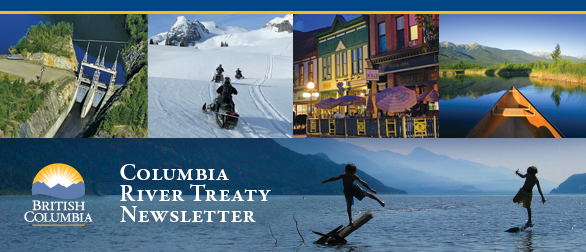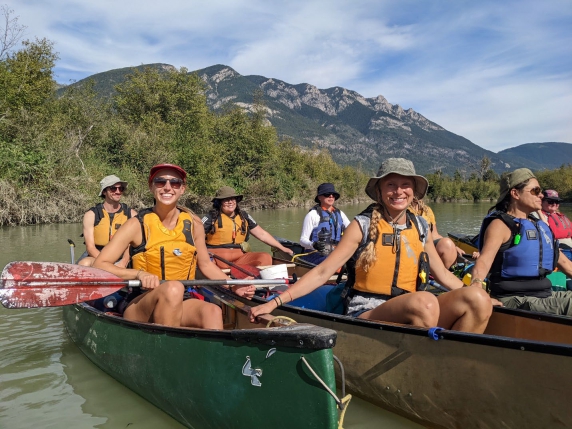Columbia River Treaty
Edition: April 2024

Youth Spotlight: Carly Christy, Middle Years Program Teacher, Mt. Sentinel Secondary
Apr 29, 2024
Carly Christy (left) canoeing the Columbia River, photo by Carly Christy
Teach the Columbia Curriculum: A Teacher’s Perspective
As a teacher, I can sometimes be weary of using premade resources in the classrooms of our Middle Years Program (MYP). Mt. Sentinel Secondary School’s MYP is an integrated grade 7/8 program that works to provide students with subject-rich, project-based and contextual learning opportunities. A one-size fits all approach doesn’t work within our program structure, therefore I often rely on my and my students’ creativity and intuition for ideas. The Teach the Columbia (TTC) curriculum package, developed by Wildsight, is an exception and has been both a quality source for lesson plans and a source of inspiration for thematic, place-based classroom learning.
I have had the opportunity to attend the Teach the Columbia Field Course for Educators in summer 2022 as well as in September 2023. These field courses bring together educators from throughout the Basin to learn about and workshop the TTC lessons, sharing ideas for ways in which to include the materials in our classrooms across grades and disciplines. The field course was particularly useful while planning for our MYP learning themes of Earth, Wind, Water, and Fire. The experience inevitably shaped my planning for our Water theme. During the field course, participating teachers took part in TTC lessons while canoeing the Columbia River. We engaged in riverside mapping exercises, paddled through the wetlands discussing ecosystem health, and journeyed through a lock system after learning about the impacts of dams. This highly contextual experience provided me with the confidence to share my learning with my classes and focus our Water theme on our local watershed.
The experience that inspired our culminating Water project occurred while participating in the TTC Field Course. A colleague had packed watercolour paints and our cohort of teachers gathered on the river’s shores creating basin-inspired paintings using the river’s beautiful water. The feeling of connectedness was so strong; I knew I wanted to recreate this with my students. The TTC curriculum provided me with coherent and place-based lesson ideas that I could modify for our younger group. With my students, I began by using the mapping activity to learn our geography, recognize map features, and notice how stakeholders are represented. We read the Ktunaxa creation story and predicted the impacts of colonial borders. The question of ‘Who speaks for the river?’ emerged. We painted the water.
While many of the lessons in the TTC curriculum are geared towards older learners (grades 9-12), the ideas themselves were accessible to younger students. As we discussed the history of the Columbia River Treaty (CRT) through articles, stories, and photographs, students found the changes to the basin, especially within their communities, striking. We continued to grapple with the question ‘Who speaks for the river?’ A large focus of our learning turned to the impact of dams and the CRT. Our school is surrounded by dams yet many of our young learners had yet to understand how they influence our country’s energy access, our watershed’s ecosystems, our international relations, and local Indigenous communities. We brought salmon eggs to raise in the classroom as we read accounts from the Ceremony of Tears at Kettle Falls. We watched our salmon grow as we learned about their resilience and significance. We painted watercolour salmon to swim through our hallways. We learned about hydroelectricity as we built circuits using turbines and analyzed water level data from dams along the river. Our integrated program allowed us the freedom to engage in the complexities of a river system without being confined by subject borders.
What I appreciated the most about the TTC curriculum was that it embraces the need to learn about a watershed holistically and therefore employs a crosscutting approach. The breadth of the resources allowed me to touch on diverse perspectives with my students but is structured in a way that would allow science or social studies teachers to utilize the lessons in a way that makes sense within their curricula. While we didn’t use every lesson, the TTC curriculum inspired our studies which led to our Water theme’s final integrated project: light up watercolour paintings. Students used their artwork to attempt to respond to that question: Who speaks for the river? While we may not have answered the question in the end, the students’ personal and diverse connections reflected the complexity of the watershed itself. And while we may have ended our theme with more questions than we started, the students’ 75 paintings honored and celebrated he Columbia River watershed beautifully.
Carly Christy (she/her/hers)
MYP Teacher, Bobcat HUB
Mt. Sentinel Secondary



